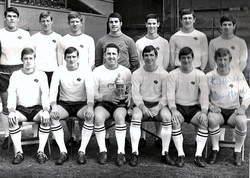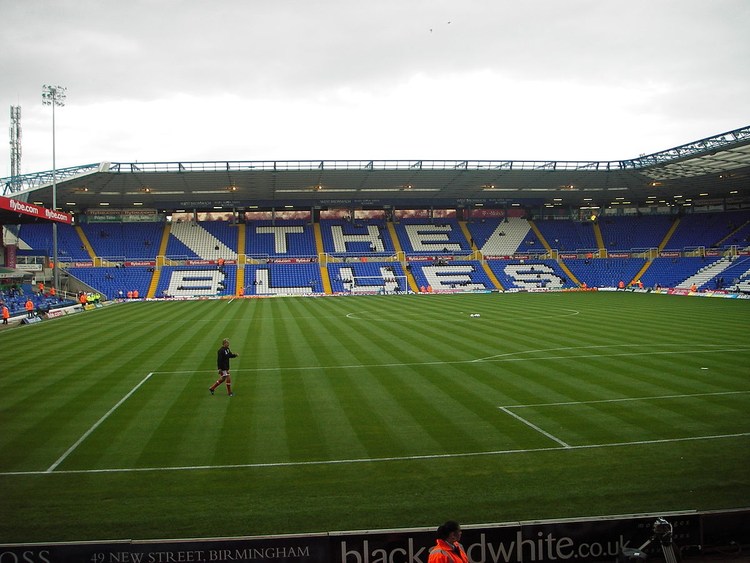Championship Stadiums & Stats

The Football League Championship, sponsored by Sky Bet, is the highest football league division in England and the second highest league overall after the Premier League. The Championship replaced the old first division in 2004 and is the richest second tier league in the world as well as the 7th richest league overall in Europe.
With three teams promoted and three clubs relegated each year, there is a turnover of 6 new teams and stadiums into the league out of 24 total. The league has a fantastic mix of stadia and teams with some very big teams constantly dropping in from the top league while at the same time smaller clubs and grounds come up from lower divisions to create an enthralling competition.
With the Premier League and its riches beckoning there is a lot of passion for promotion in this league with great attendances, away days, and a hell of a lot to play for. On this page find you can find guides to all Championship football grounds as well as stats, ticket prices, history and more.
Stadium Stats
| Stadium | Year Opened | Capacity | Ave Attendance | Record Attendance | Record Attendance Match |
|---|---|---|---|---|---|
|
Ashton Gate
Bristol City |
1887 | 27000 | 22500 | 43335 | Bristol City v Preston (1935) |
|
Bet365 Stadium
Stoke City FC |
1997 | 30089 | 22742 | 30022 | Stoke vs Evertom (17/03/2018) |
|
Bramall Lane
Sheffield United |
1855 | 32050 | 29962 | 68287 | Sheffield United v Leeds (1936) |
|
Cardiff City Stadium
Cardiff City / Wales |
2009 | 33280 | 21213 | 33280 | Wales v Belgium (2015) |
|
Carrow Road
Norwich City FC |
1935 | 27244 | 25962 | 43984 | Norwich City v Leicester (1963) |
|
Coventry Building Society Arena
Coventry City |
2005 | 32753 | 25468 | 32128 | England/Italy & Belgium/South Korea (19th Feb 2023) |
|
Deepdale
Preston North End |
1878 | 23408 | 16720 | 42684 | Preston v Arsenal (1938) |
|
Elland Road
Leeds United |
1897 | 37792 | 35984 | 57892 | Leeds v Sunderland (1967) |
|
Ewood Park
Blackburn Rovers |
1882 | 31367 | 15579 | 61783 | Blackburn v Bolton (1929) |
|
Fratton Park
Portsmouth |
1898 | 20899 | 18953 | 51385 | Portsmouth v Derby (1949) |
|
Hillsborough
Sheffield Wednesday |
1899 | 39732 | 26762 | 72841 | Sheffield Wed v Man City (1934) |
|
Home Park
Plymouth Argyle |
1893 | 17900 | 15774 | 43596 | Plymouth v Aston Villa (1936) |
|
Kassam Stadium
Oxford United |
2001 | 12500 | 8994 | 12243 | Oxford v Leyton Orient (2006) |
|
Kenilworth Road
Luton Town |
1905 | 12000 | 11244 | 30069 | Luton Town v Blackpool (1959) |
|
Liberty Stadium
Swansea AFC |
2005 | 21088 | 16586 | 20972 | Swansea City v Liverpool (2016) |
|
Loftus Road
Queens Park Rangers |
1904 | 18439 | 15957 | 35353 | QPR v Leeds United (1974) |
|
Pride Park
Derby County |
1997 | 32956 | 27278 | 33598 | England v Mexico (2001) |
|
Riverside Stadium
Middlesbrough FC |
1995 | 34742 | 27264 | 35000 | England v Slovakia (2004) |
|
The Den
Millwall |
1993 | 20146 | 16544 | 20093 | Millwall v Arsenal (1994) |
|
The Hawthorns
West Bromwich Albion FC |
1900 | 26688 | 21902 | 64815 | West Brom v Arsenal (1937) |
|
The MKM Stadium
Hull City AFC |
2002 | 25586 | 17973 | 25280 | England v Netherlands U21 (2004) |
|
The Stadium Of Light
Sunderland AFC |
1997 | 49000 | 34415 | 48353 | Sunderland v Liverpool (2002) |
|
Turf Moor
Burnley FC |
1883 | 21944 | 21153 | 54755 | Burnley v Huddersfield (1924) |
|
Vicarage Road
Watford FC |
1922 | 22220 | 18876 | 34099 | Watford v Man United (1969) |
Team Stats
| Team | Year Founded | Nickname | Team Owner |
|---|---|---|---|
| Blackburn Rovers | 1875 | Rovers, The Blue and Whites, The Riversiders | Venky's London Ltd. |
| Bristol City | 1897 | The Robins | Stephen Lansdown |
| Burnley FC | 1882 | The Clarets | ALK Capital |
| Cardiff City | 1899 | The Bluebirds | Vincent Tan |
| Coventry City | 1883 | The Sky Blues | Doug King |
| Derby County | 1884 | The Rams | David Clowes |
| Hull City | 1904 | The Tigers | Acun Medya |
| Leeds United | 1919 | The Whites, United, The Peacocks | 49ers Enterprises |
| Luton Town | 1885 | The Hatters | Luton Town Football Club 2020 Ltd |
| Middlesbrough | 1876 | The Boro, Smoggies | Steve Gibson |
| Millwall | 1885 | The Lions (Formerly known as The Dockers) | Millwall Holdings plc |
| Norwich City | 1902 | The Canaries, Yellows | Delia Smith & Michael Wynn Jones |
| Oxford United | 1893 | The U's, Yellows, The Boys from Up the Hill | Erick Thohir & Anindya Bakrie |
| Plymouth Argyle | 1886 | The Pilgrims, Argyle, The Green Army | Simon Hallett |
| Portsmouth | 1898 | Pompey | Michael Eisner (Tornante Group) |
| Preston North End | 1880 | The Lilywhites, PNE, The Whites, Preston, The Invincibles | Wordon Limited |
| Queens Park Rangers | 1886 | The Hoops, The Rs, QPR | Ruben Gnanalingam, Richard Reilly, Lakshmi Mittal |
| Sheffield United | 1889 | The Blades, Red and White Wizards | Abdullah bin Musa'ed bin Abdulaziz Al Saud, Kevin McCabe |
| Sheffield Wednesday | 1867 | The Owls | Dejphon Chansiri |
| Stoke City | 1863 | The Potters | Bet365 |
| Sunderland | 1879 | The Black Cats | Kyril Louis-Dreyfus |
| Swansea | 1912 | The Swans | Swansea Football LLC |
| Watford | 1881 | The Hornets, The Golden Boys, Yellow Army, The 'Orns | Gino Pozzo |
| West Bromwich Albion | 1878 | The Baggies, The Throstles, Albion | Bilkul Football WBA |
Ticket Prices
| Stadium | Season Ticket Price (Adult) | Season Ticket Price (Conc) | Season Ticket Price (Junior) | Match Ticket Price (Adult) | Match Ticket Price (Conc) |
|---|---|---|---|---|---|
| Blackburn Rovers | £449 - £555 | £315 - £399 | £23 - £125 | £20 - £40 | £16 - £32 |
| Bristol City | £390 - £700 | £325 - £545 | £65 - £205 | £25 - £45 | £22 - £40 |
| Burnley FC | £352 - £520 | £242 - £357 | £58 - £154 | £20 - £60 | £20 - £35 |
| Cardiff City | £329 - £579 | £219 - £449 | £89 - £369 | £22 - £36 | £15 - £31 |
| Coventry City | £400 - £550 | £360 - £550 | £125 - £550 | £24 - £37 | £19 - £32 |
| Derby County | £399 - £537 | £299.25 - £402.75 | £99.75 - £268.50 | £16 - £32 | £12 - £24 |
| Hull City | £342 - £480 | £228 - £312 | £42 - £162 | £20 - £28 | £13.5 - £18 |
| Leeds United | £508 - £710 | £400 - £540 | £72 - £194 | £32 - £47 | £25 - £32 |
| Luton Town | £530 - £530 | £330 - £410 | £150 - £180 | £20 - £32 | £12 - £24 |
| Middlesbrough | £620 - £781 | £468 - £601 | £229 - £229 | £26 - £37 | £17 - £29 |
| Millwall | £473 - £588 | £273 - £347 | £32 - £210 | £25 - £38 | £19 - £27 |
| Norwich City | £582 - £654 | £357 - £402 | £81.5 - £227.5 | £26 - £40 | £16 - £30 |
| Oxford United | £359 - £550 | £209 - £325 | £0 - £235 | £22 - £32 | £15 - £26 |
| Plymouth Argyle | £435 - £540 | £340 - £420 | £10 - £110 | £23 - £28 | £19 - £23 |
| Portsmouth | £359 - £479 | £229 - £289 | £85 - £119 | £27 - £28 | £21 - £22 |
| Preston North End | £420 - £550 | £325 - £440 | £0 - £150 | £30 - £35 | £25 - £30 |
| Queens Park Rangers | £290 - £677 | £175 - £454 | £88 - £203 | £21 - £42 | £14 - £31 |
| Sheffield United | £513 - £643 | £383 - £413 | £168 - £178 | £35 - £40 | £13 - £36 |
| Sheffield Wednesday | £595 - £825 | £330 - £455 | £23 - £150 | £27 - £59 | £17 - £49 |
| Stoke City | £344 - £519 | £259 - £399 | £23 - £179 | £20 - £40 | £15 - £32 |
| Sunderland | £440 - £590 | £310 - £400 | £75 - £150 | £25 - £40 | £18 - £18 |
| Swansea | £397 - £459 | £305 - £305 | £89 - £160 | £32.5 - £32.5 | £20 - £20 |
| Watford | £438 - £567 | £260 - £418 | £76 - £156 | £20 - £35 | £18 - £28 |
| West Bromwich Albion | £399 - £509 | £339 - £419 | £23 - £139 | £28 - £28 | £23 - £23 |
Championship Stadiums

The English Championship possibly has the most diverse mix of football stadiums in the world. Many big teams from the richest league in the world, the Premier League, drop into the Championship each year and this means that even England’s second tier can show off some huge modern super stadia.
Alongside these there are great traditional British grounds from famous clubs that have been unable to develop their grounds without Premier League cash, and finally there are some fantastic small stadiums hosting teams that have emerged from lower divisions. Take a look at some of the stats tables on this page and you will immediately see the diversity in capacities, attendances and ages the Stadiums range from.
Attendances in the English Championship both in absolute terms and as a proportion of overall capacity are incredibly high compared to many second tier divisions in Europe; in 2014-15, for example, this was 17,857. This is testament to the stadiums, the teams that play in them, and the quality of football on offer in this division. With teams like Sunderland (49,000) and Newcastle (52,405) having spent time in the division of late alongside the likes of Brentford (12,763) and Rotherham (12,021) you can see why two away days in this division are never the same.
In our stadium guides you can read about the history of these stadiums and the teams that play in them, see all of the key stats and trivia, find out all of the information you need on how to get there, how to get tickets, tours, seating plans, future developments, hospitality and more. Take a look at our photo galleries too that will give you a great feel for what it is like to visit these English Championship grounds.
- Ashton Gate
- Bet365 Stadium
- Bramall Lane
- Cardiff City Stadium
- Carrow Road
- Coventry Building Society Arena
- Deepdale
- Elland Road
- Ewood Park
- Fratton Park
- Hillsborough
- Home Park
- Kassam Stadium
- Kenilworth Road
- Liberty Stadium
- Loftus Road
- Pride Park
- Riverside Stadium
- The Den
- The Hawthorns
- The MKM Stadium
- The Stadium Of Light
- Turf Moor
- Vicarage Road
About The League

The football league was unified until 1992 when the 22 teams from the old Division One resigned on mass to set up a new league known as the Premier League. The old Division Two that had existed as such for 100 years (1892-1992) immediately became the highest football league division and was renamed the Football League First Division. Teams were still able to move between the first division and the Premier League as before but the two leagues became separate from a financial and administrative perspective. The first division was again re-branded in 2004 becoming the Football League Championship. The league is often termed the English Championship but can also include Welsh teams; both Cardiff and Swansea play or have played in this division previously.
As the seventh richest league in the world and the highest attended second division in Europe, the Championship and its teams command a lot of global respect. More games are televised from the Championship compared to major European counterparts such as the Spanish Segunda or Italian Serie B. In 2009 Sky signed a £195m three-year deal to broadcast 75 league matches and all play-off games. The league also commands a global audience since broadcast rights for the Championship are also held by at least 24 other nations around the world.
With 24 teams and 46 matches to be played the Championship usually begins in the first week of August, one week before the start of the Premier League, and runs to mid-May. The winner of the Championship earn automatic promotion to the Premier League each year along with the Football League Championship Trophy. The runner-up is promoted directly too, with 3rd through to 6th place competing in a playoff for the third promotion place. Conversely, the three lowest Premier League teams each year are relegated to the Championship and the three lowest Championship teams relegated to League One, with three League One teams promoted to take their place.

The play-off involves a two legged semi-final that takes place home and away. The 3rd placed team plays 6th place and 4th and 5th are drawn together. The remaining two teams then compete for the final play off place at Wembley Stadium. This is serious business too with Fulham, the winners of the 2020 play-off final, earning around £125m in prize money, enough to make or break a clubs ambitions.
In fact, the Championship play off final is worth more in prize money than winning the Champions League. Even teams that are relegated from the Premier League now receive parachute payments of around £25m in year one, £20m in year two and £10m in year three following the drop. You can easily see now why the Championship is the seventh richest league in the world. All this money means there are some fantastic grounds too as well as top players, managers and facilities on offer.
Leicester City and Manchester City have won the English second tier league on the most occasions both with 7 each.
Championship History

The history of the Old First Division (1892-1992) before it changed is covered on our Premier League page. The English Championship, despite taking on the name of the first division between 1993 and 2004, actually derives from the old English Second Division. The 2nd division was established in 1892, four years after the old First Division, when a rival division called the Football Alliance was merged with the existing football league to create a new football league second division. The three top Alliance clubs entered into the 1st division with the 2nd tier mainly made up of Alliance teams. The old football alliance was contested between 1889 and 1892 and hosted 12 teams, many of which have since gone out of existence or have been renamed. The Alliance was won by The Wednesday (now Sheffield Wednesday) in 1889, Stoke (now Stoke City) in 1890, and Nottingham Forest in 1892.
The original 12 members of the second division were Ardwick (now Manchester City), Bootle, Burton Swifts, Crewe Alexandra, Darwen, the valiant Grimsby Town, Lincoln City, Northwich Victoria, Port Vale, Sheffield United, Small Heath (now Birmingham City), and Walsall. In 1893 three more teams were added expanding the league to 15 teams, this increased again to 16 in 1894, 18 in 1898, 20 in 1905, 22 in 1919, 23 in 1987 and finally 24 teams in 1988.
Initially, automatic promotion did not happen, instead, the top teams from the second division and the bottom teams from division one played a series of matches. Sheffield United became the first team to be promoted from division two in 1894 because Small Heath, the champions in 1893, were denied promotion after losing their test match to Newton Heath. This system was abolished in 1898 due to match fixing between Stoke and Burnley and automatic promotion and relegation was introduced. The clubs deliberately drew the test match play-off 0-0 ensuring Burnley were promoted but Stoke could not be relegated.
The league ran this way for 100 years, with breaks for the two world wars, before taking the name of the First Division in 1993 as the old first division became defunct with the creation of the Premier League. In 2004 the league was re-branded the Coca-Cola Championship in a new sponsorship deal, the second division (the old third division) becoming League One and the third division (the old fourth division) becoming League Two. Confusing much?
Coca-Cola ended their sponsorship in 2009 and was replaced by Npower until 2013 when current sponsors Sky Bet took on a five-year deal. The latest re-branding in 2004 also came with a new trophy for winning the league, the Football League Championship Trophy.
Fulhams’s Aleksandar Mitrović is the top goalscorer netting 43 goals in the 2021-22 season.
